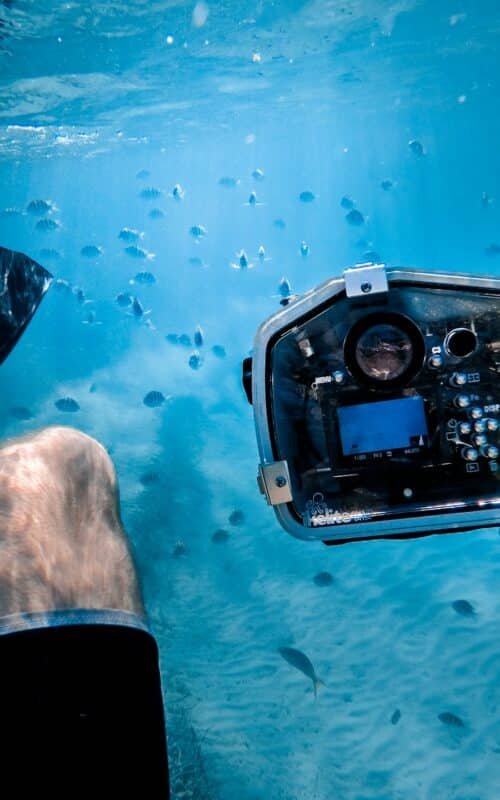Underwater photography is an incredible art form, allowing scuba divers to capture the magnificent beauty of the aquatic world and eternalise their unique experiences beneath the surface. From vibrant coral reefs teeming with life to mesmerising encounters with marine creatures, underwater photography allows divers to share the awe and wonder of the ocean with others, opening a window into a realm that few have the chance to explore firsthand.
While capturing stunning photographs underwater can be a thrilling and rewarding pursuit, it also presents a unique set of challenges. Navigating the ever-changing conditions in the depths, mastering buoyancy to avoid disturbing delicate ecosystems, and learning the intricacies of lighting and composition in an underwater environment requires not only technical skills but also patience, creativity, and determination.
In this article, we will guide you through the captivating world of underwater photography, exploring essential tips and techniques to help you hone your skills and capture mesmerising marine life images. From choosing the right camera equipment to mastering buoyancy control, understanding light and colour in the underwater environment, and improving your composition techniques, we will help you embark on your journey to becoming a proficient underwater photographer.
Are you ready to dive into the fascinating world of underwater photography and unleash your creative potential beneath the waves? Join us as we explore essential tips and techniques to capture breathtaking images of marine life, guided by the expertise and passion of the team at Master Divers. Embrace the challenge of underwater photography, expand your diving experiences, and create a visual record of your memorable encounters in the depths of the ocean.
Choosing the Right Underwater Camera Equipment
Selecting the appropriate camera gear is crucial for capturing stunning underwater photographs. Consider the following factors when choosing your underwater photography equipment:
- Camera Type: There are various camera types available for underwater photography, including compact cameras, mirrorless cameras, and digital SLR (DSLR) cameras. Each type offers different levels of image quality, control, and complexity to suit beginners and experienced photographers alike.
- Underwater Housing: To protect your camera from water and pressure, invest in quality underwater housing specifically designed for your camera model. Ensure that the housing provides easy access to all necessary buttons and controls for seamless underwater operation.
- Lighting Accessories: Natural underwater lighting can be unpredictable and challenging. Invest in underwater strobes or lights to enhance your images and ensure that the colours of marine life are accurately captured.
- Additional Gear: Consider investing in a sturdy, buoyant camera tray, which will help keep your camera stable while maintaining good buoyancy control. Don’t forget to bring a few spare memory cards and fully charged batteries.
Mastering Buoyancy and Camera Stability
Maintaining neutral buoyancy and steady camera positioning is essential for capturing sharp underwater images. Follow these tips for mastering buoyancy control and improving camera stability:
- Practice Buoyancy: Spend time in the water, perfecting your buoyancy control to become a more efficient underwater photographer. Master the art of hovering and fine-tuning your buoyancy to capture desired angles and perspectives without disturbing the environment.
- Use a Camera Tray: A camera tray is vital in enhancing your camera stability and helping you capture crisp, clear shots. It also makes handling your camera more comfortable and secure.
- Capture Images on Ascent: When photographing, consider taking your shots while ascending slightly to limit the disturbance of sediment, sand, or debris.
Understanding Light and Colour Underwater
The underwater environment poses unique lighting challenges, often resulting in unusual or muted colours in your images. Keep these light and colour considerations in mind for your underwater photography:
- Adjust White Balance: The further you descend, the more the water filters out red and orange tones, adding a blue or green hue to your images. Use your camera’s white balance settings to correct colour distortion and obtain more natural-looking results.
- Use Artificial Lighting: Underwater strobes or lights can provide additional illumination and restore natural colours to your subjects. Experiment with various lighting angles and distances to achieve optimal results.
- Shoot Upwards: By positioning your camera at an upward angle against the surface light, you can create a more natural and dynamic lighting effect, adding depth and dimension to your images.
Improving Composition Techniques
Effective image composition is crucial in capturing striking underwater images. Keep the following composition techniques in mind when framing your shots:
- Get Closer to Your Subjects: Move closer to your subjects to reduce the amount of water between your camera and the subject, resulting in clearer and more detailed images.
- Utilise the Rule of Thirds: Divide your frame into thirds and place your primary subject at the intersection of those lines to create a visually pleasing composition.
- Experiment with Angles: Capture your subjects from various angles and perspectives to create unique, dynamic images that showcase the true beauty of the underwater world.
- Be Patient: Underwater, your subjects are constantly moving and changing. Remain patient, and wait for the perfect moment to capture them in their full glory.
In Conclusion
Underwater photography allows you to preserve the beauty and wonder of the aquatic world while challenging your skills as a photographer and diver. By carefully selecting your camera equipment, refining your buoyancy control, understanding light and colour, and improving your composition techniques, you can capture breathtaking images that showcase the magic and splendour of life beneath the waves.
Unlock your creativity and explore the enchanting world of underwater photography with Master Divers’ dive courses. Hone your skills, gain practical insights, and immortalise your awe-inspiring experiences in the depths of the ocean, capturing the spellbinding beauty of our planet’s most mysterious realm.


Fantastic tips and techniques for underwater photography! I especially appreciate the advice on managing lighting and using the right gear. These insights will definitely help improve my shots on my next dive. Thanks for sharing such practical and useful information! Visit : http://www.orcadiveclub.in/